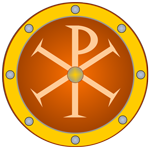
Naval battle of Chios(Campaign to Crete) |
year: 912April 912 |
| Defeat of the Byzantine fleet by the Saracens after a failed campaign in Crete | ★ ★ ★ ★ ★ |
|
enemy: Arabs (Abbasids)
|
location: South of Chios island in North Agean
|
accuracy:
●●●●●
|
|
battle type: Naval Battle |
war: Later Byzantine-Muslim Wars |
modern country:
Greece |
| ▼ The Byzantines(emperor: Leo VI the Wise) | ▼ The Enemies | |
| Commander: | Patrician Himerios | Leo of Tripoli, Damianos |
| Forces: | 187 ships | Unknown |
| Losses: |
| Background story: |
| Crete was occupied by Arabs from Andalusia in 824 and became the Arab Emirate of Crete and a base of corsairs who looted the shores of Byzantium. The Empire repeatedly tried to retake Crete, but without success. In 910s, the emperor Leo VI decided a new campaign against the Crete and appointed the patrician Himerios as leader. Himerios was considered capable and had some success against the Arabs (although he could not stop the raid in Thessaloniki in 904). In addition, he was the uncle of the Empress Zoe (Leo's 4th wife). Himerios gathered forces from all themata. The expeditionary force consisted of 187 ships and 47,327 men ( 34,200 rowers, 7,340 soldiers, 700 Varangians and 5,087 Mardaites). It was an unusually large force, much larger than any other Byzantine venture at the time. It is not entirely certain that the main objective of the operation was Crete, or that it was a naval operation generally against the Saracens in the Aegean and the eastern Mediterranean. |
The Battle: |
 Surprise attack of Saracens in the Skylitzes manuscript For this campaign, more than any other in Byzantine history, we know many details about the exact composition of the army and the salaries of the soldiers of each division. We also have meticulous records of supplies and armaments and costs for each purchase. But beyond that, we know nothing about the military operations of this expeditionary corps. The only thing that is certain is that the fleet left in August 911 and returned to the northern Aegean in April 912. It is probable that the Byzantine fleet landed in Crete and besieged Chandax, the capital of the Saracens (present-day Herakleion). The stay of the Byzantines on the island should not have been easy, judging by the difficulties faced by the better organized campaign of Phokas in 960. The siege of Chandax was deadlocked due to the strong wall and the large moat, while the defenders of the city were many and determined. In addition, the Byzantines would be constantly attacked by the Arabs of the rest of the island, something that both Phokas had to deal with in 960, but also the older missions to Crete. It is also certain that there would have been a very serious supply problem (as in 960) given the large size of the army and the many months of siege. In any case, Himerios and his fleet, having failed in Crete, sailed back in April 912. (There is also the possibility that Himerios left in a hurry when he learned that Leo VI was dying. Perhaps he believed that due to his military power he could claim the throne.) On the way to Constantinople and while a large part of the thematic army had landed on the shores of Asia Minor, the Byzantine fleet was suddenly attacked between Samos and Chios by a group of Saracens led by the Greek renegades Leon of Tripoli and Damianos of Tarsus. The defeat of the Byzantines was overwhelming and many ships were lost. Himerios himself just escaped and took refuge in Lesvos. |
Aftermath: |
| Himerios arrived in Constantinople in May 912. In the meantime Leon VI had died and was succeeded by his brother Alexander who dismissed Himerios from his duties and forced him to retire to a monastery, where he died six months later. The Byzantines attempted a new campaign in 949 that failed, and finally Crete was conquered in 961 by Nikephoros Phokas. |
|
|
